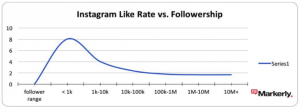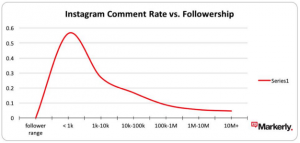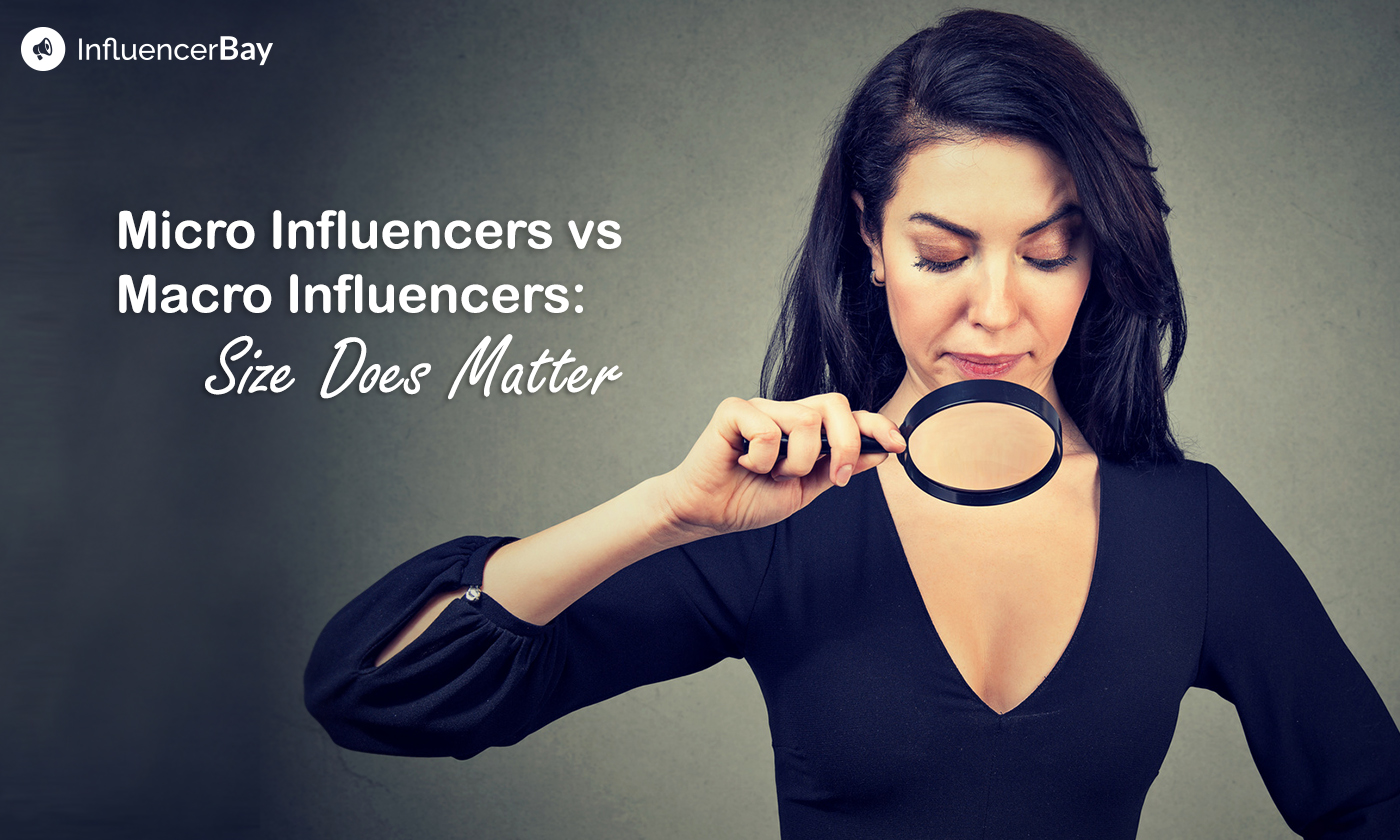In this article, I will define macro and micro influencers, compare under engagement rates, trust, reach impact and cost. I will then summarise my findings along with relevant data and examples.
Read my earlier article on “What is a Social Media Influencer”.
Micro Influencers |
Macro Influencers |
|
| Followers | 1000 – 999,999 |
1 million + |
|
Defining Characteristics |
|
|
|
Example |
Industry Experts, Bloggers, Influential Niche Market Experts, Trusted Sources |
Kylie Jenner, Selena Gomez, David Beckham |
1. Engagement
This is where the data is relevant, a 2016 study carried out by Markerly has indicated that as the number of followers increases, the level of engagement decreases:


From looking at these data sets, you are over ten times more likely to get a like or a comment when using micro influencers. This would indicate that followers of micro influencers are more interested in what they have to say and the content they share than the followers of macro influencers.
Winner: Micro Influencers
2. Trust
Collective Bias surveyed over 14,000 people relating to digital behaviour and how it may affect in store decisions.
Some of the results were huge, over 60% of people were found to have consulted blogs or social media posts on products before considering a purchase.
Highlights:
- Only 3% of people would consider buying a product in store if it was endorsed by a celebrity.
- 30% of people are more likely to purchase a product based on a recommendation from a non-celebrity blogger than a celebrity.
- 70% of 18 – 34-year-olds chose “peer” reference as the most powerful factor.
Content that comes from a micro influencer is far more credible and trustworthy. This doesn’t mean macro is bad, it has a lot more credibility than traditional advertising, but there is only one winner here.
Winner: Micro Influencers
3. Reach
One area where micro influencers fall down is reach. Let’s look at Kylie Jenner as an example, she is the leading influencer in her age group and one of the biggest in the world.
Kylie has over 90 million followers and her social media posts commonly get 1 million engagements.
How many micro influencers would you need to hire to reach this amount? 100? Would that even cover it?
Engagement is low but if your brand wants to get in front of as many people as possible and a few hundred thousand grand doesn’t deplete the marketing budget completely – macro may be the way to go.
On the flip side, if reach for you is about quality and not quantity, this needs to be considered.
Winner: Macro Influencers
4. Impact
Micro Influencers have another distinct advantage, they are generally industry or subject experts with a loyal and relevant following. Compare this to macros wide ranging passive following.
Determining who has the greater impact is not an easy step.
Let’s take an example, a luxury hotel chain wants to increase bookings across 26 countries. Which campaign would have a bigger impact?
- You could have Selena Gomez stay at the hotel and tweet from the room stating she feels wrapped in a cloud of happiness. This would reach 20+ million people, cost 300k, get low engagement rates but still clock up 500,000 likes and shares and get your brand out there in front of a huge audience.
- Alternatively, you could go with 50 lifestyle and travel bloggers, invite them to stay free of charge and write about their experience. They may also charge fees so let’s say it costs the same as the above (300k) in total.
The difference here is the micro influencer’s content will last a lot longer, reach and influence more relevant people. While the macro may cause a momentary spike in bookings, the micro influencers are a long term, targeted solution to increase your hotels standing.
Winner: Micro Influencers
5. Cost
I have purposely left this as the last factor for discussion as it is very often the make or break of a marketing campaign. High cost needs a high ROI, data powered marketing must work in this way.
The cost of macro vs micro influencers for start-ups and SME’s are straight forward, Macro is too expensive. For larger brands, however, you need to carefully weigh up the pros and cons of each. To help, I have included potential costs of working with influencers published in the New York Times.
Influencers with 3 – 7 million followers (Macro) can charge:
- $187,500 for a YouTube Post
- $75,000 for an Instagram or Snapchat post
- $30,000 for a post on Twitter
Micro Influencers, with 50,000 to 500,000 followers charge on average:
- $2,500 for Youtube
- $1000 for Instagram or Snapchat posts
- $400 for Twitter
So this data only looks at a sample and while not being an accurate guide (it only looks at 3 -7 million and 50 – 500000 followers) it gives a good overview of the difference in pricing and how to get the most value from your influencer marketing campaign.
Winner: Micro Influencers
It is easy to make a case for both as we have so many successful campaigns out there. However, from looking at the data there is a clear winner in Micro Influencers. Higher engagement, better source, a more powerful impact and a fraction of the overall cost of Macro.
Not to get caught up in the stats, but let me point out a few more reasons why we should use micro influencers:
- Nielsen reports that 90% of consumers trust peer recommendations. Only 33% trust ads. Earned reviews are far more powerful than ads, after all, you get your influencer to review your product and be honest. This will be very powerful and last a long time.
- In a study carried out by Google, 6 out of every 10 YouTube Subscribers would follow advice on what to buy from their favorite creator over their favorite TV or Movie personality. This goes to show you the strength of the relationship created by Micro Influencers.
- In the same study, 70% of YouTube subscribers say they relate more to YouTube channel creators than they do to celebrities.
Macro influencers are in demand and high cost, the only time I would recommend you go this route is if you have a huge marketing budget and a great idea for an engaged influencer to get involved.
Go with micro influencers, give them a creative licence and see where they take your brand.
